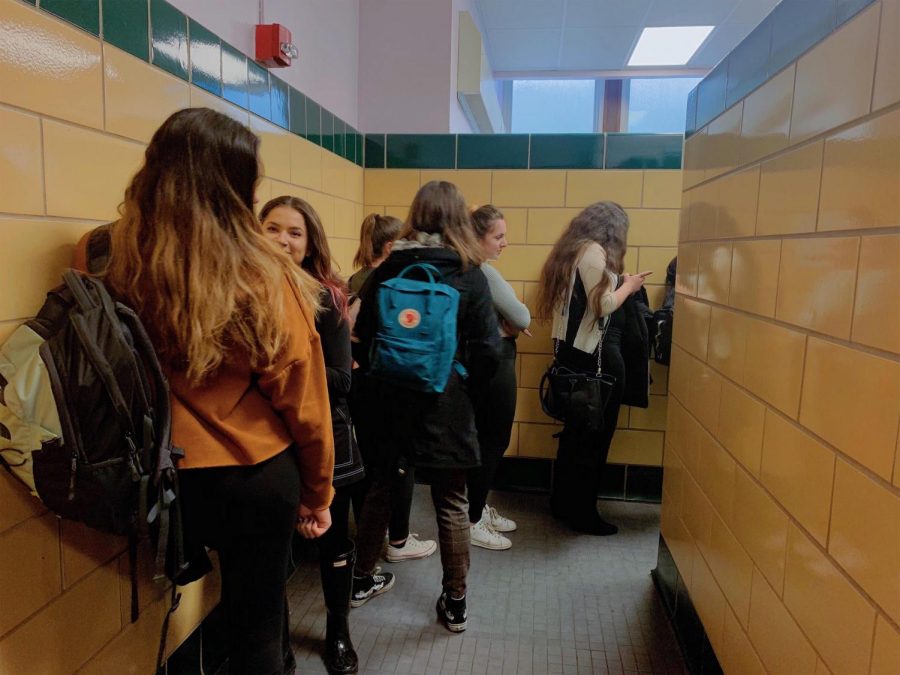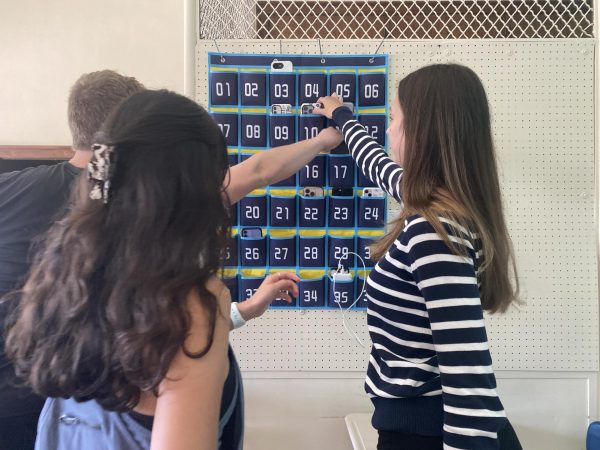Construction ends historic bathroom disparity
This article originally misstated the information regarding the number of girls initially enrolled in Lane. There were actually 275 girls enrolled in 1971, according to Michelle Weiner, a member of The Lane Alumni Association, not 600, a number originally attributed to an ACLU article.
This article also incorrectly cited Title IX as a reason of admission of female students; however, Title IX was not passed until June of 1972, shortly after Lane’s decision to allow female enrollment in September of 1971.
Avery Moss taps her foot impatiently, checking the time on her phone for what must be the tenth time. It has been almost five minutes since she got in line for the bathroom. The bell rings; she is late to class once again.
“I have to wait in a long line to go to the bathroom when it can be easily solved by adding bathrooms,” Moss, Div. 072, said.
In 1971, Lane made the historic decision to admit girls into the previously all-boys high school.
That year 275 female students enrolled, and despite their desire to learn, there were fears that the girls would not be able to handle the college preparatory classes and would ‘ruin’ the educational environment, according to Michelle Weiner, a member of The Lane Alum Society.
Title IX of the Educational Amendments Act, which prohibited sex discrimination in educational environments, was passed in 1972, only a year after Lane’s decision to allow female enrollment.
The decision to admit female students to Lane was fairly unpopular, and that year, hundreds of young men marched at The Board of Education’s doorstep, voicing their displeasure. This made shifting from an entirely male school to a co-ed environment a struggle for Lane.
Countless changes had to be made, such as creating bathrooms, locker rooms and sports teams for the new girls.
It has been nearly 50 years since those initial changes, but many feel there’s a long way to go before reaching true educational equality.
Because Lane originally only accepted male students, there had always been a clear disproportion between the number of male and female bathrooms. There were thirteen boys’ bathrooms across all floors and only seven girls’ bathrooms.
This disparity might seem small, but many students feel it affects them greatly.
Moss runs Cross Country, and is one of the many female athletes who chooses to change into their practice clothes in the bathrooms due to the lack of space in the girls’ locker room.
“After school, we need to change into our practice clothes and gear, and every single bathroom is so crowded every single day,” Moss said. “I’m constantly late to practice because there’s not enough bathrooms to accommodate the number of girls.”
It’s not only athletes who are affected by the lack of girls’ bathrooms. Any girl who wishes to use the bathroom during passing periods might find herself late to class due to the long lines. If she asks to go during class, the often farther walk to the bathroom may cause her to miss several extra minutes of class time.
“It’s really hard to explain that there’s not enough bathrooms, so I have to wait in a long line,” said Moss.
This year, however, Lane has decided to address the inconsistency in their bathrooms.
Three boys’ bathrooms located by Stairwell J on different floors have undergone construction to become girls’ bathrooms.
This has made the number of bathrooms on each floor equal for both girls and boys.
Women in Lit teacher Ms. Feuer has a unique perspective on the bathroom imbalance, as she frequently uses the student bathrooms when the teacher’s bathroom is full.
“Almost anytime I use a student bathroom, which is quite often, there is a line,” Feuer said. “Hopefully, this will make it more efficient.”
The construction for the bathrooms had been in progress since the summer, according to Mr. Ara, who oversees construction.
Ara said that many students were concerned about the disproportion, and the decision, in part, came from them.
“Once we found that out, we wanted to make it equitable and make sure the girls have the same amount of bathrooms,” Ara said.
It was not until 2018 that the claims of unequal bathroom space truly came to Lane’s attention. Many students and staff members expressed that this change will be a positive one.
“Hopefully it makes it a little bit more accessible for the girls,” Ara said. “They’ll have additional places they can go in different parts of the building, so they won’t have to walk and miss instructional time by having to get to one of the bathrooms that was further away.”
Your donations directly fund the Lane Tech student journalism program—covering essential costs like website hosting and technology not supported by our school or district. Your generosity empowers our student reporters to investigate, write, and publish impactful stories that matter to our school community.
This website is more than a publishing platform—it's an archive, a research tool, and a source of truth. Every dollar helps us preserve and grow this resource so future students can learn from and build on the work being done today.
Thank you for supporting the next generation of journalists at Lane Tech College Prep!

Monika Meyers is a senior at Lane. This is the second year she has taken Journalism and is a Features editor for The Warrior. She enjoys reading, hanging...









